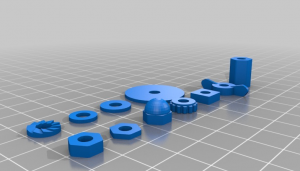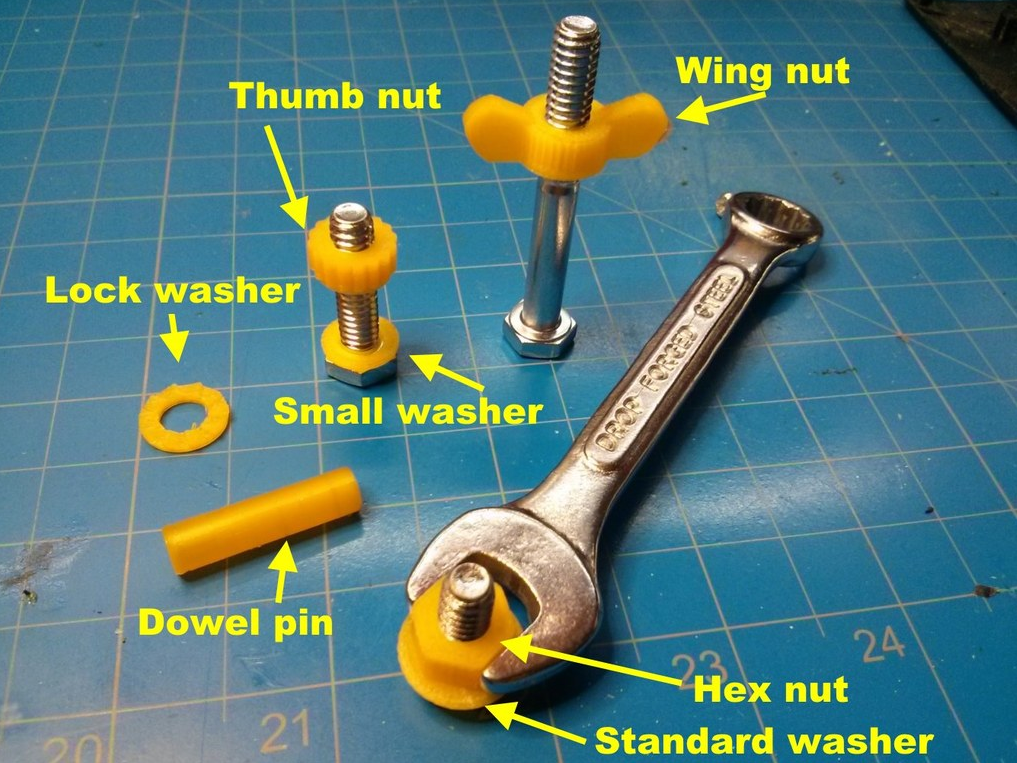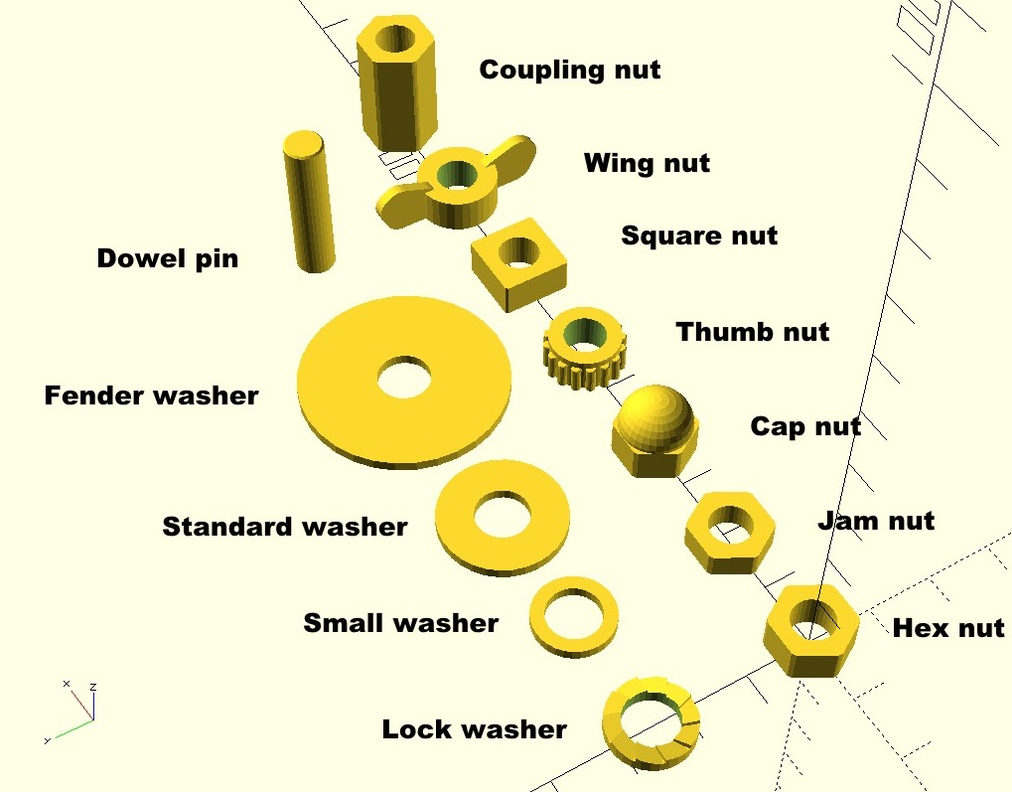Sometimes You 3D Print a Nut, Sometimes You Don’t… Now You Can 3D Print Any Nut or Washer You Choose
We’ve all seen the 3D printed nut and bolt file that 3D printer manufacturers like to show off as an example of their printers’ resolution capabilities. It is a sufficiently impressive way to showcase the level of detail a potential user can expect with a new machine. But unfortunately the 3D printed nuts and bolts aren’t going to be especially useful. The main reason is that 3D printers still aren’t capable of printing at a scale small enough for a nut to be tightened enough to work properly. Unless you glue them together the threads are simply not going to be strong enough to hold in place.
 That doesn’t mean that a 3D printer can’t help, should you find yourself short of a few parts for a build or home repair. While a 3D printed nut and bolt isn’t going to be useful together, maker and Thingiverse user Tyler Bletsch believed that a 3D printed nut could still prove extremely effective. Rather than attempt to 3D print the threads of the nut, Bletsch simply removed them, leaving a plain round hole in their place. While that would be useless for a 3D printed bolt, a metal bolt would easily be able to cut the threads directly into the plastic the first time that you use it.
That doesn’t mean that a 3D printer can’t help, should you find yourself short of a few parts for a build or home repair. While a 3D printed nut and bolt isn’t going to be useful together, maker and Thingiverse user Tyler Bletsch believed that a 3D printed nut could still prove extremely effective. Rather than attempt to 3D print the threads of the nut, Bletsch simply removed them, leaving a plain round hole in their place. While that would be useless for a 3D printed bolt, a metal bolt would easily be able to cut the threads directly into the plastic the first time that you use it.
Once Bletsch had the idea, he decided to 3D model all of the common nut and washer sizes and shapes and uploaded them to Thingiverse. He started by looking up all of the common sizes that his local hardware store kept in stock. After he had all of the sizing collated, he used OpenSCAD to model each nut. Rather than using a mouse to draw your designs, OpenSCAD allows you to simply enter individual object geometries as code. He entered a script for the standard metric and SAE nuts and washers into a table in OpenSCAD, which saved him quite a bit of time, and allowed him to set up a customizer to integrate with Thingiverse. He managed to upload all of his designs, but unfortunately the customizer wasn’t meant to be.
“The root problem is actually not on my side. My script compiles easily and quickly on my system, but for some reason the Thingiverse automated system chokes on it. Their logging system literally says nothing — it’s blank, and the ticket I filed to ask about it went unanswered. That’s why I just scripted the creation of all standard sizes locally and uploaded them. It was a straightforward ‘for each size, for each part, render it’ loop, which I was able to parallelize, so my system kicked it out in about 20 minutes,” Bletsch told us via email.
 While some may be skeptical about taking the time to 3D print a nut with no threads, in actuality using a metal bolt or screw to thread into plastic in not new. Those plastic plugs that you hammer into a wall to hold a screw in place work in essentially the same way. Plastic is extremely pliable, and metal threads can easily bore into it tight enough to stay quite secure. While 3D printed nuts are not always a suitable replacement for metal, Bletsch says there are plenty of builds and projects that they will work just as well.
While some may be skeptical about taking the time to 3D print a nut with no threads, in actuality using a metal bolt or screw to thread into plastic in not new. Those plastic plugs that you hammer into a wall to hold a screw in place work in essentially the same way. Plastic is extremely pliable, and metal threads can easily bore into it tight enough to stay quite secure. While 3D printed nuts are not always a suitable replacement for metal, Bletsch says there are plenty of builds and projects that they will work just as well.
“It’s metal threads going into plastic, so I’d say it holds up about as well as any small gadget you have that uses screws to fasten a plastic case…things like multimeters, small cheap video games, cordless phones…that kind of thing. For anything like hobby robotics, attaching electronics to a chassis, homespun 3D printer designs, non-load-bearing attachments, and covering protruding bolt shafts with cap nuts, I think they’re just fine,” Bletsch explained.
 The 3D printed plastic nuts’ advantage lies in being resistant to vibrations, not in strength or durability. Because the threads are cut into the nut the first time it is used, there is no free space between the nut and the bolt, so it isn’t going to shake apart as easy as a metal nut would. However, Bletsch does warn that no one should by any means use 3D printed nuts on anything that is load bearing–especially if the nut is holding working machinery or is required to hold any sort of weight. Additionally the nuts can be printed in either PLA or ABS, because if any strength differences between the two materials would be a factor then Bletsch said that it would be an inappropriate application to use it on.
The 3D printed plastic nuts’ advantage lies in being resistant to vibrations, not in strength or durability. Because the threads are cut into the nut the first time it is used, there is no free space between the nut and the bolt, so it isn’t going to shake apart as easy as a metal nut would. However, Bletsch does warn that no one should by any means use 3D printed nuts on anything that is load bearing–especially if the nut is holding working machinery or is required to hold any sort of weight. Additionally the nuts can be printed in either PLA or ABS, because if any strength differences between the two materials would be a factor then Bletsch said that it would be an inappropriate application to use it on.
As a professor at North Carolina State University, Bletsch is on the front lines of helping the first generation to be trained using 3D printing in school. He also has mentored a local high school robotics team called the TerrorBytes and helped his students lobby the school for their first 3D printer. In fact he credits his involvement with the TerrorBytes as being what got him interested in 3D printing in the first place.
Do you think 3D printed nuts are a good idea, or is it nuts? Let us know on our 3D Printable Nuts and Washers forum thread at 3DPB.com.
Subscribe to Our Email Newsletter
Stay up-to-date on all the latest news from the 3D printing industry and receive information and offers from third party vendors.
You May Also Like
Why Corrosive Resistant Materials Are Important to the Success of 3D Printing Across Industries
The adoption of additive manufacturing (AM) is accelerating across many major industries. As this technological shift unfolds, the importance of corrosion resistance has emerged as a challenge for 3D printing...
America Makes Announces IMPACT 2.0: $6.6M in New 3D Printing Funding
America Makes, the Manufacturing Innovation Institute (MII) based in Youngstown, Ohio, has announced IMPACT (Improvement in Manufacturing Productivity via Additive Capabilities and Techno-Economic Analysis) 2.0, a project call which will...
3D Printing Webinar and Event Roundup: April 14, 2024
We’re starting off the week’s 3D printing webinars and events at ASTM AMCOE’s 11th Snapshot Workshop and MACH Exhibition. Stratasys continues its advanced training courses, SME is holding a virtual...
AMUK Welcomes Airframe Designs as British 3D Printing Industry Grows
While the UK is not the hub for 3D printer and materials manufacturers as other nations, the country continues to excel at the research, development, and application of additive manufacturing...































